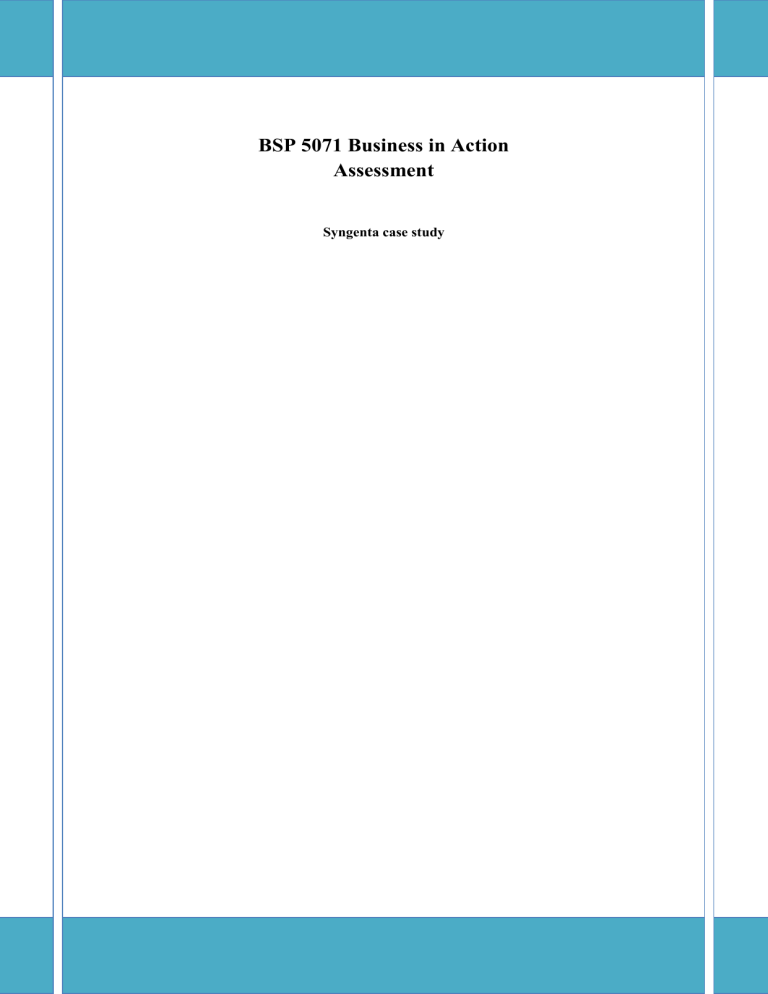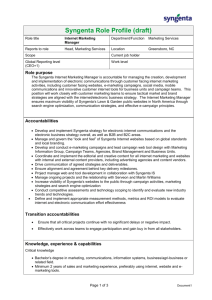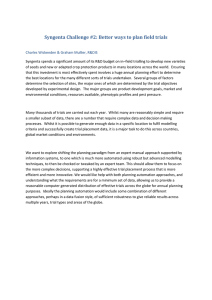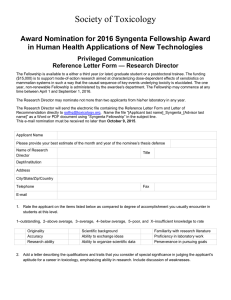
BSP 5071 Business in Action Assessment Syngenta case study Contents INTRODUCTION ......................................................................................................... 2 BACKGROUND ........................................................................................................... 3 ANSWER OF QUESTIONS ......................................................................................... 5 1.Difference between aims and objectives ................................................................. 5 2.How its values contribute to its success .................................................................. 5 3. Cutlure does not on the balance sheet, yet it is an organisation’s greatest asset .... 6 4. Importance of teamwork ........................................................................................ 7 CONCLUSIONS............................................................................................................ 9 REFERENCES ............................................................................................................ 11 1 INTRODUCTION Syngenta is a company that researches and develops crops. Syngenta could be a world-leading plant science trade. It is committed to advancing economical agribusiness through inventive inquire about and innovation. Its reason is ‘bringing plant potential to life’. Syngenta right now utilizes more than 24,000 individuals in over 90 nations. Its clients extend from agriculturists to governments. Well-qualified inventive researchers are a center quality of the commerce. In any case, the company too needs individuals in other supporting parts to guarantee the items that its researchers create can reach their chosen markets and clients. A solid center on selecting and creating its representatives makes a difference Syngenta stay a major player in a exceedingly competitive showcase. The trade prides itself on pulling in spurred, gifted and included representatives. Once individuals are selected, it completely uses the breadth and profundity of their accessible ability. Syngenta was shaped in 2000 from the merger of the agrarian divisions of Novartis and Zeneca. The company contains a wide run of item lines both in edit security (particular herbicides, non-selective herbicides, fungicides, bug sprays) and proficient items (counting grass and turf items) and seeds (field crops, vegetables) and cultivate plants. Throughout the world, agriculturists and cultivators are looking to extend the surrender from their arrive. Syngenta’s investigate groups are committed to investigating and creating items to meet around the world request from ranchers and agribusinesses for items at competitive costs. Worldwide deals in 2008 were roughly $11.6 billion, with 37% of deals in Europe, Africa and the Center East and 32% within the NAFTA locale. The case think about appears how Syngenta works in spite of the fact that a lattice structure. This includes staff from different departments working together in groups on particular ventures and assignments. This approach makes a difference to create the foremost of all employees’ abilities and capacities and empowers capacities to work together more successfully. 2 BACKGROUND To satisfy its mission successfully, a company ought to work inside a structure best suited to its purposes. Customarily huge businesses partition the association up into useful regions. Syngenta’s capacities incorporate inquire about and improvement, worldwide supply (counting fabricating), human assets (HR), deals and promoting, back, and Data Frameworks (IS). Inside any association there are likely to be a few layers of specialist. The number of levels depends upon whether the commerce features a various leveled or level structure. A progressive structure has numerous layers of administration, each with a contract span of control. Enlightening nourish downwards from one level of administration to those underneath (Jørgensen et al., 2006). The announcing framework from the best of the chain of command to the foot is known as the chain of command. A progressive structure empowers tight control. It offers clear openings for advancement and may diminish push levels in both directors and representatives. Everyone knows their put within the pecking order. Be that as it may, communication can be a issue in progressive associations. Without viable administration, it can take a long time for data to pass up and down the chain of command. Staff may not be completely engaged. Instead of being able to utilize their activity, workers may have to be look for endorsement for each activity from higher levels of administrations. This not as it were can cause delay but moreover be terrible for representative assurance, decreasing their inspiration to work (Jørgensen et al., 2006). The importance of the culture that a business has of course and is considered quite important for its development and operation, and its values are something that is analyzed and discussed in detail by experts. However, its approach is more about how it affects the well-being of employees, how it shapes the climate that prevails in the daily life of a company, how satisfied its employees are with their work, the good cooperation and communication between them (Jørgensen et al., 2006). 3 What is not emphasized enough, however, is that, it turns out, a company's culture, its principles, its values, its goals, the way it is run, have a direct impact on the customer loyalty it enjoys and, hence, in its tangible success (Salomone, 2008). In other words, the importance of a company's culture does not stop in that it is the key to a beautiful environment and satisfied employees, but it affects its customers and its revenue. A survey even showed that loyal employees can increase a company's profits by 21% and improve customer ratings by 10%. At the same time, this relationship works the other way around: companies that place more importance on profit and their financial indicators than on empathy for their people and their customers actually hurt their performance (Ruler, 2018). Of course, building such a culture is not at all theoretical; that is, it is not enough to formulate some vague principles and values and baptize them as "culture" or "value system". This is something that must be approached holistically and defined in practice, that is, in the decisions that are taken. If executives demonstrate a willingness to innovate and grow through specific decisions and moves, employees will follow suit and move in the same direction, ultimately creating a progressoriented ecosystem (Salomone, 2008). Simply put, words are not enough. To create an environment in which employees feel they can dare to step out of the fray and innovate, they need to be treated appropriately by their superiors, who must be open to discussion, receptive to new proposals, ready to take risks, move away from what is provided. Because a structured business plan may believe that it will provide them with a certain profit and satisfactory growth, but innovation and the unexpected is what can make a business take off (Salomone, 2008). In addition to being a company open to innovative decisions and moves, its willingness to see things differently, enhancing the loyalty and satisfaction of its employees, it is important to treat their own role differently. Instead of assigning her people roles and titles, it is more beneficial to assign them projects. Thus, he essentially makes the working protagonists in a specific mission, shows them in practice that he has confidence in their abilities and that he believes that they can achieve certain achievements. Through this approach, the very concept of work acquires a different concept and employees acquire purpose. This feeling is an 4 important motivator to motivate them and make them creative and effective (Luthans, 2005). After all, research shows that the most profitable companies are not the ones that are profit-oriented, but the ones that have made exactly this shift from their profit to their sense of purpose. This gives greater satisfaction to both employers and employees, which enhances their efficiency and the quality of their services, and therefore, ultimately, their profit (Luthans, 2005). ANSWER OF QUESTIONS 1.Difference between aims and objectives The case think about is based on a worldwide organization names Syngenta, which is locked in in promoting sustainable horticulture through development in inquire about and innovation. Syngenta has its operations in over 90 nations with over 24,000 staff individuals. The company’s core competency lies in well qualified and inventive staff individuals who are competent sufficient of implementing inventive techniques and in this manner contributing to plant potential to life. The key objective of Syngenta is to supply fetched viable methodology as a solution to spare plant life by conducting inquire about on advancement of trim security herbicides, insecticides, fungicides and giving life to plants. To realize its mission of expanding abdicate from plants, Syngenta has consolidated with world perceived organizations Novartis and Zeneca. In a pursuit to attain the mission, company has fragmented the organization on lattice structure of organization (Jonker and karapetrovic, 2004). 2.How its values contribute to its success The core values of a business are not necessarily recorded in a corporate manual. They are recorded in the behavior and in the way of managing the daily work. They are reflected in staff behavior either in intercompany relationships or in customer and supplier relationships. Responsibility, seriousness, innovation, teamwork, ethics, reliability, courtesy, honesty, high quality, hard work are just some of the values that could outline the value profile of your business so that you can achieve the desired 5 goals. The dissemination and observance of corporate values is the responsibility of management so as to ensure as much as possible that staff react and operate on their basis (Luthans, 2005). Syngenta is committed to enabling its staff and a various leveled structure isn't suited to its inventive fashion. Like numerous huge businesses working in both national and worldwide markets, Syngenta has received a network structure. A lattice structure is frequently alluded to as the extend group structure (Jonker and karapetrovic, 2004). 3. Cutlure does not on the balance sheet, yet it is an organisation’s greatest asset The organizational chart of the multinational company shows that the company contains a lattice structure. In spite of the fact that the structure is sweet for the company as distant as the investigate and advancement viewpoint of the company is concerned, it is named as a successful structure for speedier accomplishment of organizational objectives. Representatives are constrained to work in offices without their earlier assents, which may lead to resistance among a few specialists. It is prescribed that the organization receive a half breed framework of organizational structure –which coordinating a centralized and decentralized organizational structures (Lufthans, 2005). Business culture represents the collective values, beliefs and principles of organizational members and is the intangible asset that results from individual factors such as business history, product, market, technology, strategy, type of employees, style of management, and national culture. It is also the model of collective behaviors and assumptions taught to new members and employees as a way of perceiving, thinking and feeling (Salomone, 2008). In conclusion, business culture has the potential to influence the way people and teams interact with each other, with customers, as well as with other actors that interact (Lufthans, 2005). By defining the vision of its business, Syngenta automatically sets its goals and purpose. Next, the values are what will guide it so that it reaches the goal. Through 6 corporate culture, employees inevitably gain systematic contact with vision and values. In particular, through the various actions and activities in the context of culture, employees are given the opportunity to better consolidate these concepts, to realize their true gravity and ideally to function in a way that responds to them. At this point it should be made clear that the purpose of corporate culture is not, in any case, to change or "threaten" the personality of existing employees in Syngenta. The purpose is the improvement and evolution of people. Therefore, in their attempt to keep up with the company culture, individuals are likely to discover new elements of themselves. They can identify some of their small weaknesses, but they can also discover some of their new capabilities (Jonker and karapetrovic, 2004). In the context of corporate culture, individuals can more easily see the enormous importance of teamwork and communication. Ideally, the culture should be integrated into Syngenta, so that it is now the spontaneous, natural and effortless behavior of employees. Culture can highlight how people will communicate within the company, define acceptable and unacceptable behaviors, and clarify the landscape in terms of business principles and processes (Salomone, 2008). It is the culture in Syngenta that gives a unique, distinctive character to the company. It is reflected in everything that happens in its workplace, from the benefits it can provide to its employees to the way they socialize and they communicate with its partners, from the way we will say goodbye to their colleagues in the morning (Fairhurst, 2001). 4. Importance of teamwork The strategy of Syngenta lies on managers who work together so as to maintain focus on departments. Teamwork in the company is essential to meet stakeholder needs. Syngenta is committed to group strengthening and subsequently a progressive structure isn't reasonable for its imaginative introduction. The company has received a network framework of organizational structure. Departmentalization The organizational structure of Syngenta as outlined over appears a commonplace progressive structure in a commercial commerce. The structure is composed of four 7 utilitarian regions as demonstrated prior. For occurrence, the accounts division is made up of three layers of progression: an accounts chief, a director and three collaborators. A framework organizational structure is regularly named as the extend group structure (Widhiastuti, 2012). Group pioneers are alloted particular assignments and ventures. As such, each group will comprise of individuals from different divisions, each with their claim zones of specialization and mastery but related to the extend beneath administration. With this sort of course of action, it takes workers with diverse ability to work with other workers taken out of their regular utilitarian zones. This guarantees that the extend is well invested with all the abilities required to realize the set targets. It moreover suggests that workers will advantage from aptitudes and mastery displayed by their group individuals from diverse offices (Salomone, 2008). Group individuals ought to not as it were be put in multi-skilled groups but moreover be permitted to work in their specialized groups. Groups ought to not be haphazardly composed with individuals being constrained to work with others against their wills. Each group part ought to be included in a choice to be put into a bunch so that they can be comfortable working with their colleagues. For effectiveness and viability of the organization, the administration ought to consider executing a cross breed organizational structure for Syngenta. This sort of structure will empower workers to require portion in choice making forms particularly those that concern the groups in which they work (Fairhust, 2001). Whatever the reason for setting up the team, the individuals are its members and each member carries their own experience. Thus, different people with different experiences come together for the sake of a new mission. Everyone knows the difficulty of setting up a team with a vision and a strategic advantage over the competition. However, whoever manages to create an effective and functional team feels a deep satisfaction both as a creator and as a member. The team understands the goals and is committed to achieving them. This clear direction and agreement on mission and purpose is essential for effective teamwork. The members of the team must have jointly agreed on the mission, which is the umbrella of all its actions. This clarity is enhanced when the organization has clear expectations for the work and results of the team. At the same time, the clarity in the 8 mission helps to strengthen the self-discipline, but also to the enthusiasm that mobilizes, inspires, sensitizes all members towards a common vision (Ruler, 2018). The participants in a team are aware, they do not just love what they do, but also why they do it. They are aware of the actions, omissions and consequences of a failure in their daily lives. Practice has shown that they have more meaningful time in the workplace, often sacrificing activities of their personal life (Widhiastuti, 2012). The team creates a safe environment in which people feel comfortable taking risks. Members trust each other, they are not judged, they are not criticized and much more they are not punished when they disagree. The disagreement is expected and is appreciated positively. Consistency, honesty and conscientiousness create relationships of team endurance in adversity, overcoming difficulties, failures and unpredictable business situations in a broad business / social environment (Ruler, 2018). Team members have a strong sense of belonging. This practice of great importance gives meaning, motivates, in other words connects our existence with other people who do not necessarily have common elements of character. This whole process cultivates self-awareness, working towards trying to accept others. If you belong to the emotionally sensitive, the sense of belonging will enhance teamwork and unconditional acceptance of judgments and well-meaning criticism. The sense of belonging is enhanced and improved when the team spends time co-creating rules and guidelines for behavior. Individuals are treated as unique, with irreplaceable experiences, sensitivities, opinions, knowledge. After all, the reason for creating a team is to take advantage of diversity (Widhiastuti, 2012). CONCLUSIONS The fitting culture for Syngenta ought to be such that it not as it were emphasize on group building but moreover it ought to center on administration aptitudes as there's an environment of broadening with advancement so all the workers ought to not as it were be given multi gifted groups but they ought to too be given a chance to work in their specialized groups. Groups ought to be made after examining with work constrain so every member may well be comfortable with each other. 9 There ought to be a administration by goals in which representatives and troughs set their objectives with common assertion so each representative ought to be committed with his objective and this proprietor transport may result in accomplishment of errands in a distant better way. This continuous communication will lead to upgrade of believe and dependability among the representatives. Group pioneers ought to particularly be prepared to improve their authority abilities agreeing to particular fashion of administration important to their identity. 10 REFERENCES Fairhurst, G.T. (2001). Duralism in leadership research in Jablin, F. M. & Putnam, L. L The new handbook of organizational communication: advances in theory, research, and methods. Thousand Oaks: Sage Jørgensen, T., Remmen, A., Mellado, M. (2006). Integrated management systems three different levels of integration. Journal of Cleaner Production, 14(8): 713–22. Jonker, J., Karapetrovic, S. (2004). Systems thinking for the integration of management systems. Business Process Management Journal, 10(6): 608-615 Luthans, Fred. (2005). Organizational Behavior, 10th edition, Boston:McGraw Hill Ruler, B. (2018). Communication Theory: An Underrated Pillar on Which Strategic Communication Rests, International Journal of Strategic Communication, 12:4: 367381 Salomone, R. (2008). Integrated management systems: experiences in Italian organizations. Journal of Cleaner Production, 16(16): 1786–806. Widhiastuti, H. (2012), Τhe effectiveness of communications in hierarchical organizational structure, International Journal of Social Science and Humanity, 2(3): 112-121 11




